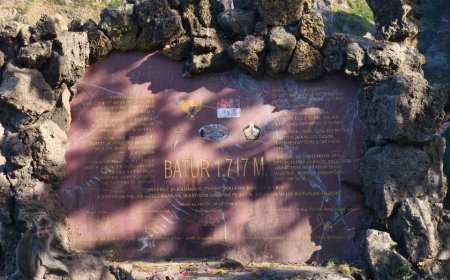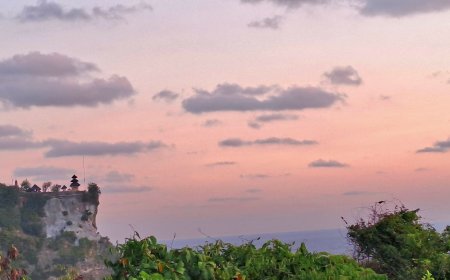Pura Goa Giri Putri : A Marvelous Spiritual Wonder Inside the Enchanting Cave
Pura Goa Giri Putri is a sacred cave temple on Nusa Penida Island, Bali, that combines the beauty of nature, mythological history, and the harmony between Hinduism and Buddhism. Located inside a cave with a unique entrance, the temple offers a spiritual and fascinating exploration experience. Pura Goa Giri Putri is a place of beauty and profound significance, featuring stunning natural formations like stalagmites and stalactites and serving as a habitat for a bat population. Additionally, the cave provides a tranquil meditation facility, creating a deep spiritual experience for those seeking it. Goa Giri Putri is a unique place in Bali that harmoniously blends natural beauty, historical significance, and diverse beliefs.

Bali, the Heavenly Island of Indonesia, enchants with its beautiful natural charms, rich culture, and astonishing spiritual sites. One of the most prominent spiritual places in Bali is Pura Goa Giri Putri, a place of worship nestled inside a natural cave. This temple is not only a significant spiritual destination but also offers a unique exploration experience amidst Bali's mesmerizing natural surroundings.
The name 'Goa Giri Putri' holds a profound meaning in the Balinese language, perfectly reflecting the location and spiritual significance of this sacred place. The word 'Goa' means cave, while 'Giri' refers to a mountain or hill. In the context of Hindu teachings, the word 'putri' carries symbolism as the embodiment of God's power and might, radiating the qualities of femininity or womanhood. In other words, 'Goa Giri Putri' is a term that refers to a cave that serves as a hollow or sacred space where the power and might of God are present in its manifestation as a beautiful woman known as 'Hyang Giri Putri.' This is one aspect of God's power that symbolizes femininity and spiritual strength in the form of Shiva
In the Babad Nusa Penida, it is explained that the name Goa Giri Putri originates from the divine power of Lord Shiva. It is recorded that in the Saka year 50, Lord Shiva descended to Earth along with Goddess Uma and their followers on a mountain named Gunung Puncak Mundhi. On this mountain, Lord Shiva and the goddess Uma transformed from divine beings into humans. Lord Shiva took on the form of a man, assuming the role of a Pandita who resided in Dukuh Jumpungan. The name Dukuh Jumpungan signifies the dwelling of a Manusa Pandita. From these events, the name eventually evolved into Nusa Penida. Apart from descending on Gunung Puncak Mundhi, Lord Shiva also descended to another location in the Saka year 55, which is now known as Tunjuk Pusuh. However, in the Saka year 45, Goddess Kwan Im descended first and established her abode in a cave. Later, Goddess Parvati descended to Earth in the Saka year 60, followed by various other gods and goddesses such as Lord Brahma, Mahadewa, Ganapati, Gangga, Tri Purusha, and Basukih. The cave is now known as Goa Giri Putri, signifying its central role in the universe, while Goddess Parvati, bearing the title Hyang Giri Putri, serves as the guardian of the holy water (tirta) within Pura Goa Giri Putri.

Pura Goa Giri Putri (Photo Source: Personal Collection)
Based on the geographical data provided by Warmadewa University in 2007, Goa Giri Putri is approximately 262 meters long and located around 150 meters above sea level. Upon entering this cave, visitors embark on an extraordinary journey into a magical underground world. Inside the cave, one's eyes will be treated to the beauty of astonishing natural features. There is a flowing water channel that shimmers, creating a peaceful and calming atmosphere. The stunning stalagmites and stalactites form peculiar and beautiful stone formations along the way. Not only that, but the cave is also home to a population of bats, adding to the mysterious ambiance of this place. However, it's not just the captivating natural beauty but also the strong mystical aura that is felt here. The cave's atmosphere provides a profound spiritual experience for visitors, making them feel connected to the remarkable underground world and nature.

Pura Goa Giri Putri Entrance (Photo Source: Editorial Collection)
The uniqueness of Pura Goa Giri Putri extends beyond its stunning natural beauty and also encompasses its unique and mystical entrance. The cave's entrance is as narrow as a bucket, and at first glance, it might seem impossible for adults to pass through. However, in reality, visitors can navigate this entrance quite smoothly. Upon successfully entering, visitors are greeted with a spacious and large chamber inside the cave, which can accommodate around 5000 people. This sensation is both mesmerizing and surprising. The cave's exit is larger in size and equipped with a door, unlike the entrance. Initially, visitors could also enter through the back entrance of the cave; however, nowadays, both tourists and worshippers are directed to enter through the main entrance (hole) from the temple courtyard.
This concept of the cave entrance and path inside is believed to reflect the mythology of human life, starting from emerging from the womb, crawling through a journey, and eventually reaching the phase of adulthood, where one can stand upright. Furthermore, Pura Goa Giri Putri has a close connection with two other major temples on Nusa Penida Island, namely Pura Puncak Mundi and Pura Dalem Ped. During the grand ceremonies held in the tenth month of the Bali calendar (sasih kadasa) every year, the Grand Ceremony is also celebrated at Pura Puncak Mundi and Pura Dalem Ped. Therefore, when people visit Nusa Penida for the purpose of worship, these three temples become their primary destinations. This creates a profound spiritual experience for visitors who feel connected to the rich spiritual and cultural heritage of Bali.

Goddess Kwan Im Statue (Photo Source: Personal Collection)
Another unique feature inside Pura Goa Giri Putri is the presence of the Goddess Kwan Im statue, representing the acculturation of beliefs between Hinduism and Buddhism. In Buddhist tradition, Goddess Kwan Im is regarded as a deity who bestows blessings, provides prosperity, and symbolizes gratitude for harvests, especially those from the sea and fields in Nusa Penida, Nusa Lembongan, and Nusa Ceningan. The presence of the Goddess Kwan Im statue in Pura Goa Giri Putri is an extraordinary reflection of the harmony between Hindu and Buddhist beliefs in Bali. In the process of worship at Pura Goa Giri Putri, the area surrounding the Goddess Kwan Im statue holds significant importance in the religious rituals performed by Hindu devotees. This is a tangible example of how various beliefs can coexist and mutually respect each other in this beautiful environment. While there is no exact explanation of how the acculturation of Hindu-Buddhist beliefs occurred, the presence of the original Goddess Kwan Im statue at the back of the cave and the larger statue visible from the front signifies a valuable historical heritage.
According to the explanation from one of the temple priests (pemangku) at Pura Goa Giri Putri, the original Goddess Kwan Im statue is located at the back of the cave, while the larger statue seen from the front is a newer addition. However, from the cave's perspective, the original statue is still clearly visible. In the past, there were efforts to relocate the Goddess Kwan Im statue, but it was said to bring adverse effects to the surrounding community. Therefore, the Goddess Kwan Im statue was ultimately left in its original place. This adds depth to the meaning and uniqueness of Pura Goa Giri Putri as a sacred place that harmoniously blends various aspects of life and beliefs.
In addition to being a place of worship and a tourist destination, Pura Goa Giri Putri in Nusa Penida also offers specialized facilities for meditation. In the middle of the cave, right in front of the main temple, there is a staircase that leads upward within the cave. There, visitors will find a naturally formed chamber designed specifically for meditation. However, it's important to note that only those who wish to meditate are allowed to ascend to this area. Additionally, visitors who intend to meditate must remove all footwear before entering the meditation chamber. This creates a tranquil and contemplative atmosphere within the beautiful cave, allowing spiritual seekers to attain peace and serenity through meditation. Practicing meditation in a place like this can provide a profound spiritual experience for those who seek it.






























































